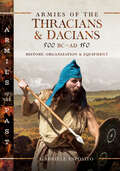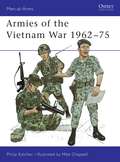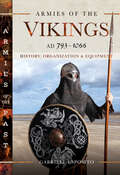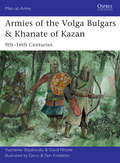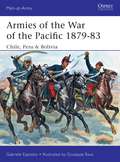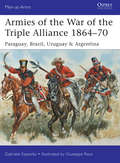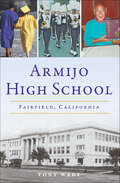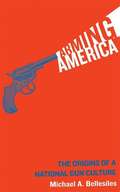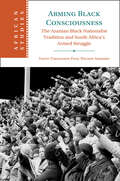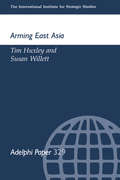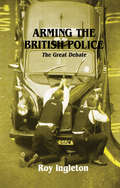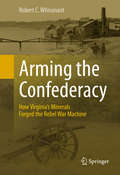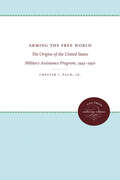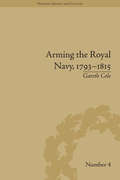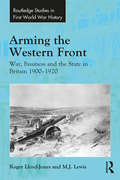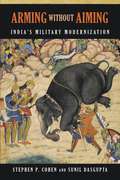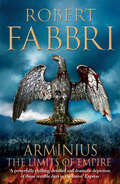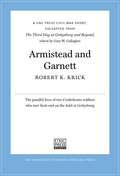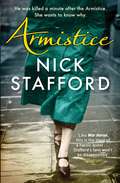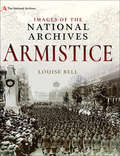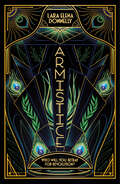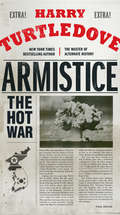- Table View
- List View
Armies of the Thracians & Dacians, 500 BC–AD 150: History, Organization & Equipment (Armies of the Past)
by Gabriele EspositoContains 80 detailed photographs and illustrations of equipment used by these warring armies who dominated the ancient world.The Thracians are mentioned as early as in the epic poems by Homer and were fundamental in the evolution of the Greek military systems across the ages. They fought in the Persian Wars, were part of Alexander the Great's army, were used as mercenaries in many Hellenistic armies and resisted Roman conquest for a long time. In addition, they used some iconic weapons and had a distincitve panoply. The Dacians were a mix of different cultures and were extremely influenced by some steppe peoples like the Sarmatians. They had a lot in common with the Thracians but had a different history. They formed one of the largest and most powerful kingdoms of Antiquity, a sort of super-power that dominated over the Balkans. Their wars against Trajan and the Roman Army were absolutely epic, the last campaigns of conquest in the history of the Western Roman Empire. The book contains a rich collection of photos specifically made for it by some excellent groups of reenactors.
Armies of the Vietnam War 1962-75
by Mike Chappell Philip KatcherPhilip Katcher provides an overview to the conflict that engulfed Vietnam following the division of the country into two along the 17th Parallel in 1954. The uniforms and insignia of the US forces, including the army, Special Forces, air force, navy and marine corps, are dealt with in detail, together with those of the ARVN, the Allied Forces (such as the Royal Thai Army and Korean troops), and also the Communist NLF (Viet Cong) and NVA forces. Mike Chappell's colourful artwork provides plenty of detail to accompany this authoritative text.
Armies of the Vikings, AD 793–1066: History, Organization and Equipment (Armies of the Past)
by Gabriele EspositoViking warriors were feared by their contemporaries and their ferocious reputation has survived down to the present day. This book covers the military history of the Vikings from their early raiding to the final failure of their expansionist ambitions directed against England. In that period Viking warbands and increasingly large armies had left their Scandinavian homelands to range across vast regions, including the whole of Northern Europe and beyond, even reaching North America. The British Isles were terrorized for two centuries and at times largely conquered, in Normandy, Russia and elsewhere they also settled and founded states. Tough, skilled and resourceful, with a culture that embraced the pursuit of immortal fame and a heroic death in battle, their renown as warriors was second to none. As far afield as Constantinople, the Byzantine emperors employed them as their elite Varangian Guard. Gabriele Esposito outlines the history of their campaigns and battles and examines in detail their strategy, tactics, weapons, armour and clothing. The subject is brought to life by dozens of color photographs of replica equipment in use.
Armies of the Volga Bulgars & Khanate of Kazan
by Gerry Embleton Viacheslav ShpakovskyFacing off against Byzantines, Arabs, Vikings, Turks, Mongols, and Russians, this steppe culture dominated Black Sea and Caucasus trade during Medieval times.The Bulgars were a Turkic people who established a state north of the Black Sea, and who showed similarities with the Alans and Sarmatians. In the late 500s and early 600s AD their state fragmented under pressure from the Khazars; one group moved south into what became Bulgaria, but the rest moved north during the 7th and 8th centuries to the basin of the Volga river. There they remained under Khazar domination until the Khazar Khanate was defeated by Kievan (Scandinavian) Russia in 965. Thereafter the Volga Bulgars - controlling an extensive area surrounding an important hub of international trade - became richer and more influential; they embraced Islam, becoming the most northerly of medieval peoples to do so. Given their central position on trade routes, their armies were noted for the splendour of their armour and weapons, which drew upon both Western and Eastern sources and influences (as, eventually, did their fighting tactics).In the 1220s they managed to maul Genghis Khan's Mongols, who returned to devastate their towns in revenge. By the 1350s they had recovered much of their wealth, but they were caught in the middle between the Tatar Golden Horde and the Christian Russian principalities. They were ravaged by these two armies in turn on several occasions between 1360 and 1431. A new city then rose from the ashes - Kazan, originally called New Bulgar - and the successor Islamic Khanate of Kazan resisted the Russians until falling to Ivan the Terrible in 1552. The costumes, armament, armour and fighting methods of the Volga Bulgars during this momentous period are explored in this fully illustrated study.
Armies of the War of the Pacific 1879-83
by Gabriele EspositoThe Pacific War was the climax of the decades-long Wars of Liberation, and is one of the most important conflicts in South American history. After winning their independence from Spain in 1825, Peru and Bolivia became separate nations - but over the following years repeated attempts to re-unite them were frustrated by the neighboring powers, particularly Chile. By the 1870s Chilean military superiority and expansionist policies exploded into full scale conflict. This book examines the troops, uniforms and equipment used by forces on all three sides of the conflict and traces the events of the war from the early naval blockades to the full-scale amphibious landings undertaken by the Chilean forces. The war ended in total victory for Chile, and that country's emergence thereafter as 'the Prussia of South America', while it cost Peru a lucrative province, and Bolivia its outlet to the Pacific coast.
Armies of the War of the Triple Alliance 1864-70
by Giuseppe Rava Gabriele EspositoBetween 1864 and 1870 four nations fought in an extraordinarily bloody war - the largest in the history of South America. The powerhouses Argentina and Brazil alongside tiny Uruguay on one side, and the small but increasingly-powerful Paraguay on the other, fought a conflict that was almost contemporary with the American Civil War and Franco-Prussian War, and rivalled their very high casualty rates. The aftermath of the war saw defeated Paraguay's territory diminished, its total population reduced by a staggering 70 per cent, and its economy ruined for generations, while victorious Brazil was established as the predominant military power on the continent. Despite the extraordinary ferocity of the fighting and the significant historical consequences thereafter, little has been published in English on a war that shaped the political map of Latin America to this day. This title book in some crucial gaps by telling the story of the men who fought on both sides, using contemporary paintings, prints, and rare early photographs combined with detailed research and engaging analysis.
Armijo High School: Fairfield, California (Landmarks)
by Tony WadeOver a century of history, pride and tradition. Armijo High School opened its doors for the first time in 1891. What began in the upstairs classrooms of Crystal Elementary School in Suisun City grew to the sprawling campus on Washington Street in order to serve the rising population of Fairfield, California. Armijo alumni have made indelible marks in numerous fields, including medicine, law, civil and military service, athletics, and the arts. Notable graduates include Noriyuki "Pat" Morita who earned an Academy Award nomination for playing Mr. Miyagi in The Karate Kid movies, New York Giants Super Bowl champion George Martin and Johnny Colla, multi-platinum recording artist with Huey Lewis and the News. Join Tony Wade as he delves into the generations of students, parents and faculty that embody Armijo pride.
Arming America: The Origins of a National Gun Culture
by Michael A. BellesilesBellesiles (history, Emory U. ) explodes a number of myths about the role of guns in American history. Examining probate records, correspondence of militia commanders, and a number of other sources he finds that gun ownership among average Americans wasn't widespread until as late as the Civil War. He also argues that from the very beginning of European settlement, guns were highly regulated by authorities and that guns were viewed as having a special status as being ultimately at the disposal of government.
Arming Black Consciousness: The Azanian Black Nationalist Tradition and South Africa's Armed Struggle (African Studies #164)
by Toivo Tukongeni AsheekeSince 1994, as the ruling party in South Africa, the ANC have become synonymous with and indivisible from the fight against apartheid rule. This has left little space for competing accounts, visions, and political projects to find their appropriate place in the historical narrative. In this innovative book, Toivo Asheeke moves beyond these well-trodden histories, to tell the previously neglected story of the Black Consciousness Movement (BCM), a militant revolutionary nationalist wing of the anti-colonial struggle. Using archival sources from four countries and interviews with former veterans of the movement, Asheeke explores the BCM's engagement with guerrilla warfare, community feminism and Black Internationalism. Uncovering the personal and political histories of those who have previously received scant scholarly attention, Asheeke both illuminates the history of Africa's decolonization struggle and that of the wider Cold War.
Arming East Russia (Adelphi series)
by Tim Huxley Susan WillettDuring the 1990s, military spending, arms procurement and defence industrialisation have all increased rapidly in East Asia. Although these developments do not constitute an arms race, they nevertheless have important implications for suppliers of defence equipment, for arms control and for regional stability. This paper assesses trends in the defence spending of East Asian states, particularly in the light of the economic crisis, which began in mid-1997. It also focuses on three closely-related issues: the nature of the regional market for defence equipment; defence industrialisation; and the effect of trends in defence procurement and industrialisation on East Asian states' military capabilities, and on the regional military balance.
Arming Slaves: From Classical Times to the Modern Age
by Christopher Leslie Brown Philip D. MorganArming slaves as soldiers is a counterintuitive idea. Yet throughout history, in many varied societies, slaveholders have entrusted slaves with the use of deadly force. This book is the first to survey the practice broadly across space and time, encompassing the cultures of classical Greece, the early Islamic kingdoms of the Near East, West and East Africa, the British and French Caribbean, the United States, and Latin America. To facilitate cross-cultural comparisons, each chapter addresses four crucial issues: the social and cultural facts regarding the arming of slaves, the experience of slave soldiers, the ideological origins and consequences of equipping enslaved peoples for battle, and the impact of the practice on the status of slaves and slavery itself. What emerges from the book is a new historical understanding: the arming of slaves is neither uncommon nor paradoxical but is instead both predictable and explicable.
Arming and Disarming
by R. Blake BrownFrom the École Polytechnique shootings of 1989 to the political controversy surrounding the elimination of the federal long-gun registry, the issue of gun control has been a subject of fierce debate in Canada. But in fact, firearm regulation has been a sharply contested issue in the country since Confederation. Arming and Disarming offers the first comprehensive history of gun control in Canada from the colonial period to the present.In this sweeping, immersive book, R. Blake Brown outlines efforts to regulate the use of guns by young people, punish the misuse of arms, impose licensing regimes, and create firearm registries. Brown also challenges many popular assumptions about Canadian history, suggesting that gun ownership was far from universal during much of the colonial period, and that many nineteenth century lawyers - including John A. Macdonald - believed in a limited right to bear arms.Arming and Disarming provides a careful exploration of how social, economic, cultural, legal, and constitutional concerns shaped gun legislation and its implementation, as well as how these factors defined Canada's historical and contemporary 'gun culture.'
Arming the British Police: The Great Debate
by Roy IngletonAs the fear of violent crime escalates, there are calls for the police to carry guns. This examination of the history of violent crime and violence against the representatives of law and order looks at the extent to which the "unarmed" British police have had recourse to firearms in the past.
Arming the Confederacy: How Virginia’s Minerals Forged the Rebel War Machine
by Robert C. WhisonantThis is a fresh look at the American Civil War from the standpoint of the natural resources necessary to keep the armies in the field. This story of the links between minerals, topography, and the war in western Virginia now comes to light in a way that enhances our understanding of America's greatest trial. Five mineral products - niter, lead, salt, iron, and coal - were absolutely essential to wage war in the 1860s. For the armies of the South, those resources were concentrated in the remote Appalachian highlands of southwestern Virginia. From the beginning of the war, the Union knew that the key to victory was the destruction or occupation of the mines, furnaces, and forges located there, as well as the railroad that moved the resources to where they were desperately needed. To achieve this, Federal forces repeatedly advanced into the treacherous mountainous terrain to fight some of the most savage battles of the War.
Arming the Free World: The Origins of the United States Military Assistance Program, 1945-1950
by Chester J. PachIn this important study, Chester Pach traces the emergence of military assistance as a major instrument of contemporary American foreign policy. During the early Cold War, arms aid grew from a few country and regional programs into a worldwide effort with an annual cost of more than $1 billion. Pach analyzes the Truman administration's increasing reliance on arms aid--for Latin America, Greece and Turkey, China, and Western Europe--to contain Communist expansion during the late 1940s. He shows that a crucial event was the passage of the Mutual Defense Assistance Act of 1949, the progenitor of a long series of global, Cold War arms measures.Pach demonstrates that the main impetus for the startling growth of military assistance was a belief that it would provide critical political and psychological reassurance to friendly nations. Although this aid was ostensibly provided for military purposes, the overriding goals were insuring goodwill, raising foreign morale, stiffening the will to resist communism, and proving American resolve and reliability.Policymakers, Pach contends, confused means with ends by stressing the symbolic importance of furnishing aid. They sought additional appropriations with the threat that any diminution or cessation of aid suggested a weakening of American commitment. Pach reveals that civilian, not military, officials were the principal advocates of the expansion of military aid, and he shows how the policies established during the Truman administration continued to exert a profound influence throughout the Cold War.Some officials questioned the self-perpetuating qualities of military aid programs, but Pach concludes that their warnings went unheeded. Although fiscal restraints in the Truman administration temporarily stemmed the growth of aid, the Korean War exploded budgetary limitations. MIlitary assistance spending expanded rapidly in size and scope, gaining a momentum that succeeding administrations could not resist.Originally published in 1991.A UNC Press Enduring Edition -- UNC Press Enduring Editions use the latest in digital technology to make available again books from our distinguished backlist that were previously out of print. These editions are published unaltered from the original, and are presented in affordable paperback formats, bringing readers both historical and cultural value.
Arming the Periphery
by Emrys ChewA major historical study of the global arms trade, revolving around the transfer of small arms from metropolitan Europe to the turbulent frontiers of Indian Ocean societies during the 'long' nineteenth century (c. 1780-1914).
Arming the Royal Navy, 1793–1815: The Office of Ordnance and the State (Warfare, Society and Culture #4)
by Gareth ColeThe Office of Ordnance has been ill-served by previous accounts of its role in arming the Royal Navy during the French Revolution and Napoleonic Wars. Cole offers an in-depth examination of its organizational structure and demonstrates how the department responded to the pressures of war over an extended period of time.
Arming the Western Front: War, Business and the State in Britain 1900–1920 (Routledge Studies in First World War History)
by Roger Lloyd-Jones M.J. LewisThe First World War was above all a war of logistics. Whilst the conflict will forever be remembered for the mud and slaughter of the Western Front, it was a war won on the factory floor as much as the battlefield. Examining the war from an industrial perspective, Arming the Western Front examines how the British between 1900 and 1920 set about mobilising economic and human resources to meet the challenge of 'industrial war'. Beginning with an assessment of the run up to war, the book examines Edwardian business-state relations in terms of armament supply. It then outlines events during the first year of the war, taking a critical view of competing constructs of the war and considering how these influenced decision makers in both the private and public domains. This sets the framework for an examination of the response of business firms to the demand for 'shells more shells', and their varying ability to innovate and manage changing methods of production and organisation. The outcome, a central theme of the book, was a complex and evolving trade-off between the quantity and quality of munitions supply, an issue that became particularly acute during the Battle of the Somme in 1916. This deepened the economic and political tensions between the military, the Ministry of Munitions, and private engineering contractors as the pressure to increase output accelerated markedly in the search for victory on the western front. The Great War created a dual army, one in the field, the other at home producing munitions, and the final section of the book examines the tensions between the two as the country strove for final victory and faced the challenges of the transition to the peace time economy.
Arming without Aiming
by Sunil Dasgupta Stephen P. CohenIndia has long been motivated to modernize its military, and it now has the resources. But so far, the drive to rebuild has lacked a critical component-strategic military planning. India's approach of arming without strategic purpose remains viable, however, as it seeks great-power accommodation of its rise and does not want to appear threatening. What should we anticipate from this effort in the future, and what are the likely ramifications? Stephen Cohen and Sunil Dasgupta answer those crucial questions in a book so timely that it reached number two on the nonfiction bestseller list in India."Two years after the publication of Arming without Aiming, our view is that India's strategic restraint and its consequent institutional arrangement remain in place. We do not want to predict that India's military-strategic restraint will last forever, but we do expect that the deeper problems in Indian defense policy will continue to slow down military modernization."-from the preface to the paperback edition
Arminius: The Limits of Empire
by Robert FabbriAD 9: In the depths of the Teutoburg Wald, in a landscape riven by ravines, darkened by ancient oak and bisected by fast-flowing streams, Arminius of the Cherusci led a confederation of six Germanic tribes in the annihilation of three Roman legions. Deep in the forest almost 20,000 men were massacred without mercy; fewer than 200 of them ever made it back across the Rhine. To Rome's shame, three sacred Eagles were lost that day. But Arminius wasn't brought up in Germania Magna—he had been raised as a Roman. This is the story of how Arminius came to turn his back on the people who raised him and went on to commit a betrayal so great and so deep, it echoed through the ages.
Armistead and Garnett
by Robert K. KrickVirginians Lewis A. Armistead and Richard B. Garnett, two Confederate officers killed during Pickett's Charge at Gettysburg, lived remarkably parallel lives. In this Civil War Short, Robert K. Krick follows the two men from their early military careers fighting against American Indians and Mormons through two decades of military service and onto the field at Gettysburg, where both were mortally wounded. The work was originally published in The Third Day at Gettysburg and Beyond, edited by Gary W. Gallagher, which combines fresh evidence with the reinterpretation of standard sources to testify to the enduring impact of the Civil War on our national consciousness and refocus our view of the third day at Gettysburg. UNC Press Civil War Shorts excerpt rousing narratives from distinguished books published by the University of North Carolina Press on the military, political, social, and cultural history of the Civil War era. Produced exclusively in ebook format, they focus on pivotal moments and figures and are intended to provide a concise introduction, stir the imagination, and encourage further exploration of the topic. For in-depth analysis, contextualization, and perspective, we invite readers to consider the original publications from which these works are drawn.
Armistice
by Nick StaffordPhilomena Bligh's fiancé, Dan, has been shot. The First World War claimed many lives and so his death is not, in its own way, surprising. But Dan was shot in the minutes after the Armistice. The war was over.She cannot understand how this could have happened, or why they were still fighting that morning anyway. So, in March 1919, over Dan's birthday, Philomena travels to London to meet the men who were with him when he died. What she discovers is more shocking than she'd ever imagined. Dan's best friend, Jonathan, tells her that Dan was shot by a British officer over a gambling debt. There is no proof and all records of Jonathan's accusation have been destroyed.Refusing to accept anything less than justice for the man she loved, Philomena decides to take on the Establishment. Worried that she may cause his own downfall and feeling guilty for his mysterious part in Dan's death, Jonathan decides to accompany her on her mission.Set against a backdrop of London in the aftermath of the Great War, a time of upheaval, grief and wanton escapism, this is not just an inspirational book about what it means to be a hero, but also a breathtaking love story.
Armistice: Armistice (Images of the National Archives)
by Louise Bell11th November 1918 saw the signing of the armistice that ended fighting between the Allies and Germany.This book will take the reader through the final year of the First World War and everything that led up to this day. Starting from the Spring Offensive, photos and images from The National Archives will highlight important points ranging from the last 100 days to the signing of the various treaties before this final armistice, finishing with a look at the Peace Parade in 1919. The physical and mental effects of the war will also be examined, and show how the war never really ended in 1918 for many.Many rarely seen images will be provided to support the narrative and further highlight the depth of The National Archives' First World War records.
Armistice: Book 2 In The Amberlough Dossier (Amberlough Dossier #2)
by Lara Elena DonnellyArmistice returns to Donnelly’s ravishing 1930s Art Deco-tinged fantasy world of the Nebula and Lambda Award-nominated Amberlough with a decadent, tumultuous mixture of sex, politics, and spies“A hefty novel full of fascinating characters exploring oversized topics such as sexuality, music, culture, fascism, nationalism, class wars, revolution and love.” —Shelf AwarenessIn a tropical country where shadowy political affairs lurk behind the scenes of its glamorous film industry, three people maneuver inside a high stakes game of statecraft and espionage: Lillian, a reluctant diplomat serving a fascist nation,Aristide, an expatriate film director running from lost love and a criminal past,—and Cordelia, a former cabaret stripper turned legendary revolutionary. Each one harbors dangerous knowledge that can upturn a nation. When their fates collide, machinations are put into play, unexpected alliances are built, and long-held secrets are exposed. Everything is barreling towards an international revolt...and only the wiliest ones will be prepared for what comes next.For Amberlough: “James Bond by way of Oscar Wilde.”—Holly Black“Astonishing!” —World Fantasy Award-winning author Ellen Kushner“Beautiful, all too real, and full of pain. Read it. It will change you.” —Hugo Award-winning author Mary Robinette KowalAt the Publisher's request, this title is being sold without Digital Rights Management Software (DRM) applied.
Armistice: The Hot War (The Hot War #3)
by Harry TurtledoveIn the final book of the blistering trilogy The Hot War, old hatreds and new chances for revenge are unleashed on an already devastated world—as the Cold War becomes a roaring inferno.In 1952 American cities lie in ruins. President Harry Truman, in office since 1945, presides over a makeshift government in Philadelphia, suffering his own personal loss and fearing for the future of democracy. In the wake of Hitler’s reign, Germany and America have become allies, and Stalin’s vise hold on power in the USSR persists. Unwilling to trust the Soviet tyrant, Truman launches a long-planned nuclear strike on the city of Omsk—killing Stalin and plunging the Red Army into leaderless, destructive anarchy. Meanwhile, the Baltic states careen toward rebellion, and Poland is seized by rebels bred on war. In a world awash with victims turned victors, refugees, and killers, has Truman struck a blow for peace or fueled more chaos? As these staggering events unfold, the lives of men and women across battle lines, ethnicities, and religions play out across the globe. In Los Angeles, an extended Jewish family builds a future, while the foul smell of a refugee camp in Santa Monica blows in on the ocean breeze. In Korea, a U.S. fighter struggles to bring his Korean interpreter stateside as a full American. In Siberia, two German women fight for their survival in a gulag—and begin a strange, harrowing journey home. From the terrifying global chess match between superpowers to the strength of individual human conscience, Armistice captures a world that’s been split to its core by the violence only mankind can create. Through the thunder of battle, the clashes of armies, and the whispers of lovers, how humanity will be rebuilt, and who will do it, are the questions that resound in this marvelous work of imagination and history. PRAISE FOR HARRY TURTLEDOVE “Turtledove is the standard-bearer for alternate history.”—USA Today Fallout “No one writes alternate-history novels quite like Turtledove. . . . Expect epic political stakes as well as personal and heartfelt stories of war.”—BookTrib Bombs Away “Turtledove’s thorough research and grounded imagination work to create a frighteningly realistic past where world leaders act out of desperation and fatalism and a large cast of common folk suffer the consequences. . . . The vicarious sense of eschatological dread is always powerful.”—Booklist Last Orders “All quite plausible . . . Turtledove’s focus on the characters serves to fill out the big picture with patient, nitty-gritty detail. . . . Armchair warriors will have much to ponder.”—Kirkus Reviews Two Fronts “A you-are-there chronicle of battle on land and sea and in the air.”—Tor.com
